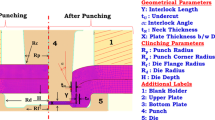Abstract
Large components, for instance in the energy industry, mining and heavy machinery, are produced from high weight cast as ingots followed by open-die forging. Besides achieving a certain final geometry and microstructure, one of the main objectives during the forging process is the elimination of casting defects, like voids from the solidification shrinkage. This process is divided in the two stages of void closure and void healing. During the healing of the closed void a solid bond is established at high temperature. In literature void closure in open die forging is thoroughly investigated. Concerning the healing by solid bond generation there are only few studies related to voids in open die forging but there is substantial literature related to bond formation in roll hot bonding and diffusion bonding. Most of this work however determines the bond strength after cooling to room temperature. Concerning future appropriate modelling of the closure and healing process in open die forging, it is important to decide, whether a bond, which was established in one forging stroke, would be strong enough to withstand the following strokes. As a first step in this direction, this paper experimentally examines the bond strength directly after bond formation under conditions typical for open die forging strokes. The results quantitatively confirm the expected influence of forming temperature, surface enlargement, holding time and oxide films.















Similar content being viewed by others
References
Campbell J (2011) Complete casting handbook. Butterworth-Heinemann, Oxford
Dudra SP, Im YT (1990) Analysis of void closure in open-die forging. Int J Mach Tools Manuf 30(1):65–75
Saby M, Bouchard PO, Bernacki M (2015) A geometry-dependent model for void closure in hot metal forming. Finite Elem Anal Des 105:63–78
Mikloweit A, Bambach M, Hirt G (2014) Development of a testing procedure to determine the bond strength in joining-by-forming processes. Adv Mater Res 966-967:481–488
Keife H, Stahlberg U (1980) Influence of pressure on the closure of voids during plastic deformation. J Mech Work Technol 4(2):133–143
Tanaka M, Ono S, Tsuneno M, Iwadate T (1987) An analysis of void crushing during flat die free forging. Advanced Technology of Plasticity 11:1035–1042
Zhang XX, Cui ZS, Chen W, Li Y (2009) A criterion for void closure in large ingots during hot forging. J Mater Process Technol 209(4):1950–1959
Huang HG, Xu SM, Wang W, Du FS (2011) Research on voids deformation welding condition for manufacturing of heavy forgings. J Shanghai Jiatong Univ 16(2):203–208
Hauri J, Graf M, Awiszus B, Kawalla R (2018) Closing of shrinkage cavities by means of open-die forging. Mater Sci Forum 918:77–84
Park CY, Yang DY (1996) A study of void crushing in large forgings I: bonding mechanism and estimation model for bonding efficiency. J Mater Process Technol 57(1-2):129–140
Park CY, Yang DY (1997) A study of void crushing in large forgings II: estimation of bonding efficiency by finite-element analysis. J Mater Process Technol 72(1):32–41
Bay N (1982) Mechanisms Producing Metallic Bonds in Cold Welding. Paper presented at the 63rd AWS Annual Meeting in Kansas City – Missouri, 26–30 April 1982
Bay N, Clemensen C, Juelstorp O, Wanheim T (1985) Bond strength in cold roll bonding. CIRP 34(1):221–224
Bambach M, Pietryga M, Mikloweit A, Hirt G, Karhausen K (2014) Finite element implementation of a bonding model and application to roll bonding of aluminium sheets of largely different yield strength. Mater Sci Forum 783-786:644–650
Pietryga M, Lohmar J, Hirt G (2016) A new FE-model for the investigation of bond formation and failure in roll bonding processes. Mater Sci Forum 854:152–157
Kazakov NF (1985) Diffusion bonding of materials. Mir Publishers, Moscow
AISE Steel Foundation (2003) The making, shaping and treating of steel – casting volume 11, Association of Iron and Steel. Engineers, Pittsburgh
Spittel M, Spittel T (2009) Materials: Metal Forming Data of Ferrous Alloys – deformation beahviour, Landolt Börnstein, Group VII Advanced Materials and Technologies 2C1: AISI 4137 715–718; AISI 304 420–423; AISI H13 292–295, Springer, Berlin Heidelberg New York
Saby M (2013) Understanding and modeling of void closure mechanisms in hot metal forming processes. Dissertation, MINES ParisTech
Acknowledgements
The author would like to thank the Deutsche Forschungsgemeinschaft DFG for the support of these works within the project HI790/53-1 “Kriterien zum Verschließen und Verschweißen von Poren beim Freiformschmieden”.
Author information
Authors and Affiliations
Corresponding author
Ethics declarations
Conflict of interest
The authors declare that they have no conflict of interest.
Additional information
Publisher’s note
Springer Nature remains neutral with regard to jurisdictional claims in published maps and institutional affiliations.
Rights and permissions
About this article
Cite this article
Hibbe, P., Hirt, G. Analysis of the bond strength of voids closed by open-die forging. Int J Mater Form 13, 117–126 (2020). https://doi.org/10.1007/s12289-019-01474-7
Received:
Accepted:
Published:
Issue Date:
DOI: https://doi.org/10.1007/s12289-019-01474-7




